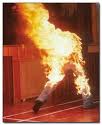Login form
Spontaneous Human Combustion – SHC
 Spontaneous human combustion (SHC) refers to the belief that the human body sometimes burns without an external source of ignition. There is much speculation and controversy regarding SHC, for it is not a proven natural phenomenon. Many theories and hypotheses have attempted to explain how SHC might occur, but those which rely on current scientific understanding say that instances mistaken for spontaneous combustion actually required a source of ignition. One such hypothesis is the "wick effect", in which the clothing of the victim soaks up melted human fat and acts like the wick of a candle. Another possibility is that the clothing is caused to burn by a discharge of static electricity. The likelihood that truly spontaneous human combustion actually takes place is remote, due to the presence of water and the lack of highly flammable compounds and oxygen in the human body.
Spontaneous human combustion (SHC) refers to the belief that the human body sometimes burns without an external source of ignition. There is much speculation and controversy regarding SHC, for it is not a proven natural phenomenon. Many theories and hypotheses have attempted to explain how SHC might occur, but those which rely on current scientific understanding say that instances mistaken for spontaneous combustion actually required a source of ignition. One such hypothesis is the "wick effect", in which the clothing of the victim soaks up melted human fat and acts like the wick of a candle. Another possibility is that the clothing is caused to burn by a discharge of static electricity. The likelihood that truly spontaneous human combustion actually takes place is remote, due to the presence of water and the lack of highly flammable compounds and oxygen in the human body.
For a number of years, scientists have tried to find a logical solution for this mystery. First, they have realized that the reason extremities like feet sometimes aren't turned into ashes is that fire usually burns upwards; it rarely burns laterally. The flames have enough material to sustain them by consuming the upper body without having to go down to the feet.The fat content of the human body is not challenged. Tests have proven that flesh and bones contain enough flammable material to sustain a fire. A "wick-effect" from human body fat could be at play and fire can burn hot enough to consume even bones. What is contested is that nothing in humans could actually ignite it all. The results of an experiment proved this point further...In popular articles, the characteristic sign of SHC is said to be the complete combustion of a body with the exception of the extremitiesólegs, hands, or headówith only an ashlike substance left in the thoracic and abdominal areas. At the same time, little or no destruction of the surroundings (beds, chairs, and so on) is observed. Frequently, however, a brown oily residue is deposited on the furniture and walls. Proponents of SHC attribute such unusual scenes to an unknown or bizarre power source, but in all such deaths documented in forensic literature, there has been no need to resort to bizarre explanations to account for the observed facts. The main objection that supporters of SHC have to such ordinary explanations is that they doubt that the course of an event can be demonstrated in retrospect, especially in cases of burning. This is not true. Forensic examination of charred remains will reveal many clues. Forensic scientists, medical examiners, pathologists, and police experts are able to deduce a great deal of information from very severely burnt bodies, even from ashes and the remains left after cremation . The presence of alcohol in the body is commonly thought to be responsible for rapid and intense combustion .This is a misunderstanding. The concentration of alcohol in a body would be much too low (try to ignite beer with a conventional flame). Diluted alcohol will neither burn nor spontaneously explode. Oxygen has to be present to allow ignition and combustion. For example, at room temperature the only way to make gasoline explode with a conventional flame is to let it vaporize in a dosed container and then set the gas on fire. In a human body, an explosion, or perhaps even fast burning due to flammable liquids, is impossible.
The presence of alcohol in the body is commonly thought to be responsible for rapid and intense combustion .This is a misunderstanding. The concentration of alcohol in a body would be much too low (try to ignite beer with a conventional flame). Diluted alcohol will neither burn nor spontaneously explode. Oxygen has to be present to allow ignition and combustion. For example, at room temperature the only way to make gasoline explode with a conventional flame is to let it vaporize in a dosed container and then set the gas on fire. In a human body, an explosion, or perhaps even fast burning due to flammable liquids, is impossible.

